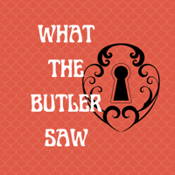
Overview
Synopsis
What the Butler Saw, Joe Orton’s final play, is an intensely funny farce set in the sexually charged private clinic of psychiatrist, Dr. Prentice. As the play opens, Dr. Prentice is interviewing the young, attractive Geraldine Barclay to be his new secretary. During her brief interview, she reveals that she has recently lost her adoptive mother after a gas explosion, and does not know the true parentage of either of her parents. Unbeknown to Geraldine, Dr. Prentice is also doing his best to seduce her but his efforts are thwarted throughout the course of the day. As Geraldine undresses behind a screen (as part of Dr. Prentice’s “examination”), the psychiatrist’s wife, Mrs. Prentice, interrupts them, dressed only in her underwear. While Geraldine is concealed, it emerges that Mrs. Prentice is being blackmailed by a young bellboy named Nicholas Beckett, after spending the night with him at the Station Hotel. To avoid scandal, she promises the post of secretary to Beckett, unaware that her husband is interviewing Geraldine for the same position. Mayhem ensues as Geraldine, Beckett, and a local policeman, Sergeant Match, all disrobe and swap clothes as Dr. Prentice attempts to keep some sort of order in his chaotic clinic.
Dr. Rance, a crazed psychiatrist, comes to the clinic in the midst of the chaos to carry out a government inspection. As he diagnoses madness all round, and subsequently tries to section most of those present, the truth about Geraldine and Nicholas Beckett’s parentage is revealed. Both Geraldine and Nicholas reveal halves of a locket that was given to them by their birth mother before she abandoned them. Mrs. Prentice recognizes the locket, revealing that she was seduced in a closet at the Station Hotel, while working as a chambermaid shortly before her marriage. Dr. Prentice then reveals that the locket was originally his and given to the woman whom he also seduced before his marriage. Realizing their pre-marital liaison, the couple are amazed, yet strangely delighted, by their incestuous behavior towards their newly discovered children. The strange group leave the clinic, bedraggled and disrobed, to face the world together.
Show Information
Context
Joe Orton's What the Butler Saw emerged from the vibrant yet turbulent cultural landscape of 1960s Britain, a period marked by sexual liberation, the decriminalization of homosexuality in 1967, and shifting social norms that contrasted sharply with lingering post-war conservatism. Born in 1933 into a working-class family in Leicester, Orton experienced emotional distance at home and pursued acting at the Royal Academy of Dramatic Arts, where he met his long-term partner, Kenneth Halliwell.
to read the context for What The Butler Saw and to unlock other amazing theatre resources!Plot
Act One
The play begins with Dr. Prentice interviewing Geraldine Barclay for a secretarial position. When it becomes clear that she is utterly unqualified, he attempts to seduce her instead. Their encounter is abruptly interrupted by the arrival of his wife, Mrs. Prentice, accompanied by Nicholas Beckett, a pageboy from the nearby Station Hotel. Mrs. Prentice accuses Nick of sexually assaulting her, but Nick reveals that he has compromising photographs of their encounter. Using this as
to read the plot for What The Butler Saw and to unlock other amazing theatre resources!Characters
| Name | Part Size | Gender | Vocal Part |
|---|---|---|---|
|
Lead |
Male |
Non-singer |
|
|
Lead |
Female |
Non-singer |
|
|
Lead |
Female |
Non-singer |
|
|
Lead |
Male |
Non-singer |
|
|
Lead |
Male |
Non-singer |
|
|
Supporting |
Male |
Non-singer |
Songs
A song with an asterisk (*) before the title indicates a dance number; a character listed in a song with an asterisk (*) by the character's name indicates that the character exclusively serves as a dancer in this song, which is sung by other characters.
Monologues
Scenes
Key Terms
An adaptation is a reworking of a story from one medium or cultural context into another, such as turning a novel into a play or updating a classic play’s setting. Adaptations often reinterpret themes, characters, and style for new audiences. They can range from faithful recreations to bold reimaginings.
Comedy that treats disturbing or taboo subjects with irony, often found in satire or plays with existential themes.
A genre that combines elements of humor and morbidity, exploring serious themes through satire or irony.
Farce is a comedic style that emphasizes exaggerated situations, improbable coincidences, mistaken identities, and rapid pacing. It often includes physical humor such as slamming doors, frantic chases, or characters hiding in plain sight. Farce is designed to generate nonstop laughter, often prioritizing chaos and absurdity over realistic storytelling.
Sexual relations between people classed as being too closely related to marry each other.
The head of an elected government; the principal minister of a sovereign or state.
A system of psychological theory and therapy that aims to treat mental conditions by investigating the interaction of conscious and unconscious elements in the mind and bringing repressed fears and conflicts into the conscious mind by techniques such as dream interpretation and free association.
A revival is a new production of a play or musical after its original run has ended, often reimagined for a new generation of audiences. Revivals may stay faithful to the original staging or update elements like design, casting, or interpretation. They are a cornerstone of theatre tradition, keeping classic works alive and relevant.
Videos
Quizzes
Themes, Symbols & Motifs
THEMES
Madness and Sanity
In Joe Orton's
to read about the themes, symbols and motifs from What The Butler Saw and to unlock other amazing theatre resources!Quote Analysis
_"Pull yourself together. Why have you been certified
to read our analysis of select quotes from What The Butler Saw and to unlock other amazing theatre resources!